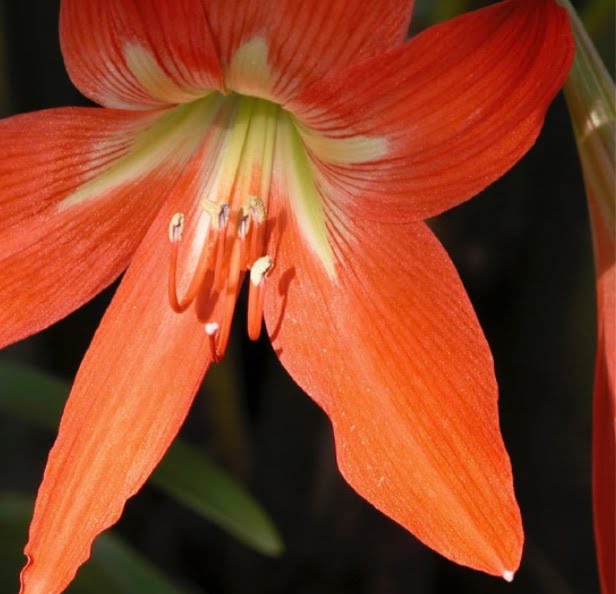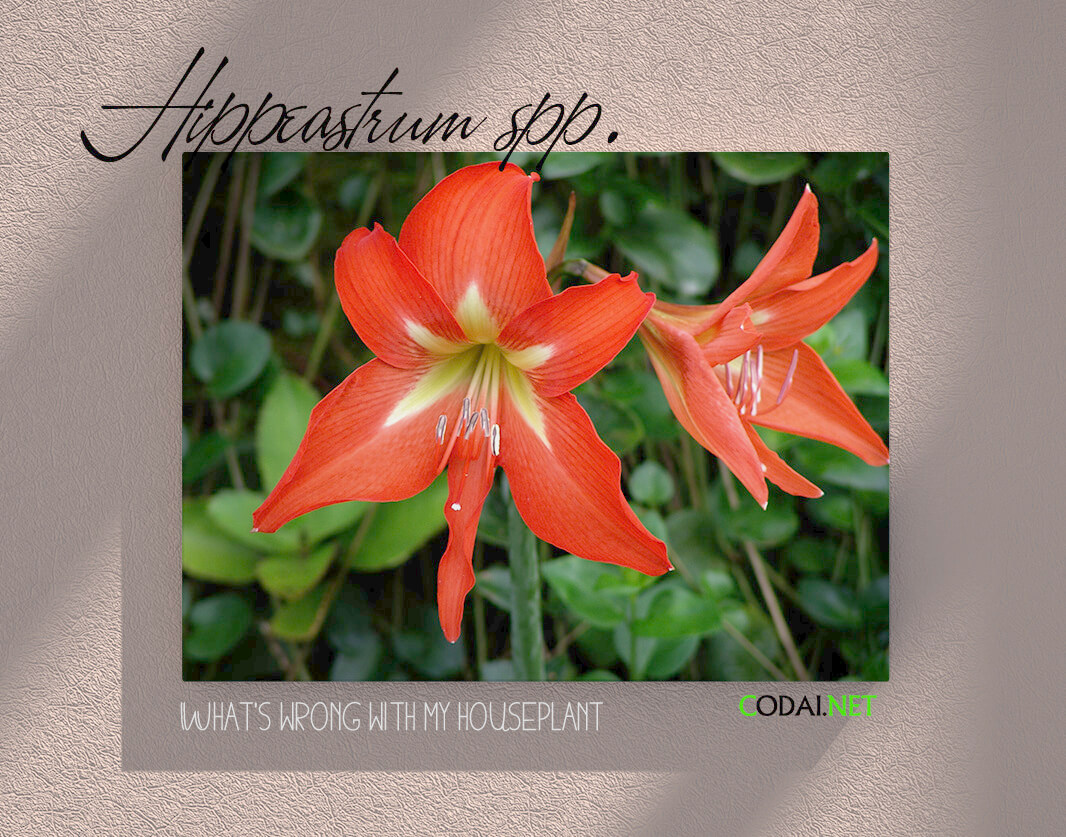[Ebook Việt Hoá] What's wrong with my houseplant (Có vấn đề gì với cây trong nhà của tôi?) - David Deardorff & Kathryn Wadsworth, Chi Hippeastrum - Chi Lan Huệ
[Ebook Việt Hoá] What’s wrong with my houseplant?: Amaryllis (Hippeastrum spp.)
- Biên tập: Dũng Cá Xinh
- Người dịch: Mai Nhung
ENGLISH
Huge, red, and incredible don’t begin to describe the amazing amaryllis (Hippeastrum spp.), a beloved winter holiday gift. The first thing to emerge from your potted bulb will be bright green, strap-shaped leaves. As they elongate, a thick flower stalk begins to grow straight up from the center of the foliage. Maybe a week later, enormous flower buds develop on top of the stalk and slowly begin to open. In a couple of days, flowers will be fully open, with petals spread wide. The sight will knock your socks off! Every year during the winter holiday sea- son, millions of amaryllis bulbs find their way into garden centers, supermarkets, and big box stores. They come in attractive, full-color boxes displaying photos of their stunningly gorgeous flowers. Each box contains a complete kit with the bulb, a pot, and a bag of potting medium. All one has to do is plant the bulb in the pot and, in a few short weeks, just in time for Christ- mas it will flower gloriously. Modern hybrids have been developed from six different species,H. aulicum, H. leopoldii, H. pardinum, H. puni- ceum, H. reginae, and H. vittatum. The huge flowers come in various shades of red, pink, salmon, near-orange, creamy yellow, or white. Some are striped, or have colored petal edges (picotee), or are variously streaked and spotted. The plant has two or three flowers, each 8 to 9 inches across, borne in a cluster atop a hollow 2-foot-tall stem.

When it’s finished flowering, cut the flower stalk off 3 to 5 inches above the bulb. Do not cut off any of the leaves, and be careful not to dam- age them. Since amaryllis is a perennial bulb, the leaves must make enough food to store in the bulb to flower again next year, and the plant can best accomplish that task by being outdoors in dappled shade through the growing season. So, in spring, after all danger of frost has passed, put your amaryllis outdoors. Then, before any expected frost, bring it back inside and put it in a dark place at 50 to 55°F. Amaryllis needs this cold treatment for eight to ten weeks in order
to flower. During this cold-dark treatment the foliage turns brown and dies back. Just cut the dead leaves off. Don’t water it during this time. While it’s dormant take it out of the pot; remove the used potting medium and replace it with fresh potting medium. After your cold treat- ment, bring the dormant bulb in its pot out into light and warmth and start watering it. Soon this temporary houseplant will flower again—just in time for another holiday season, if you’ve timed it right.
OPTIMUM HOUSEHOLD ENVIRONMENT
Read the Introduction for the specifics of each recommendation.
MEDIUM LIGHT.
Bright filtered light but no direct sun is best for amaryllis.
MODERATE TEMPERATURE.
Daytime 70 to 80°F, nighttime 60 to 70°F.
MODERATE WATER.
Water whenever the top of the potting medium becomes dry to a depth of 1 inch.
HUMIDITY.
Put the pot in a saucer or tray of water, making sure the bottom of the pot never sits directly in the water by raising the pot up on pot feet or pebbles.
POTTING MEDIUM.
Use any good organic, general-purpose potting soil that incorporates organic fertilizer, mycorrhizal fungi, and other beneficial microbes.
FERTILIZER.
Use any organic fertilizer where the second number (phosphorus) is higher than the other two to promote flowering. While the plant is in flower, use a liquid fertilizer. During the summer, use dry fertilizer.
POTTING.
Re-pot annually when dormant, and be sure the top third of the bulb is not buried in the potting medium. If the bulb appears to be root- bound, up-pot to a container with a diameter 2 inches larger than the current pot.
PROPAGATION.
Like all hybrids, amaryllis hybrids don’t come true from seed. They’re propagated asexually. Slice the bulb from top to bottom into 12 pieces. Be sure each piece has a chunk of the basal plate and a few bulb scales. Plant each piece in damp vermiculite and keep them in the dark. The pieces will grow tiny little bulbs called bulbils that can then be planted and grown on into mature plants.
COMMON PROBLEMS
Watch for failure to flower (page 247), mealy- bugs (page 262), and leaf spot fungus (page 269).
Tiếng Việt
Một loại cây rất lớn, màu đỏ và có nhiều điều thú vị là cây hoa Loa Kèn Đỏ (Hippeastrum spp.), Một loại cây được yêu thích trong kỳ nghỉ mùa đông. Thứ đầu tiên nổi lên từ bầu đất sẽ là những chiếc lá hình dây đeo màu xanh lá cây tươi sáng. Khi chúng dài ra, một cuống hoa dày bắt đầu mọc thẳng lên từ tâm của tán lá. Có thể một tuần sau, những nụ hoa to lớn phát triển trên đầu cuống và từ từ bắt đầu hé nở. Trong một vài ngày, hoa sẽ nở hoàn toàn, với những cánh hoa xòe rộng. Tầm nhìn của bạn sẽ được rộng mở! Mỗi năm trong kỳ nghỉ đông ở biển, hàng triệu cây hoa Loa Kèn Đỏ (Hippeastrum spp.) được tìm kiếm ở các trung tâm vườn, siêu thị và cửa hàng hộp lớn. Chúng được đựng trong những chiếc hộp đầy màu sắc, hấp dẫn trưng bày những bức ảnh về những bông hoa lộng lẫy tuyệt đẹp của chúng. Mỗi hộp chứa một bộ dụng cụ hoàn chỉnh với bầu, chậu và một túi bầu. Tất cả những gì phải làm là trồng củ vào trong chậu và trong vài tuần ngắn ngủi, để đúng lúc Chúa giáng sinh, cây sẽ ra hoa rực rỡ. Các giống lai hiện đại đã được phát triển từ sáu loài khác nhau, H. aulicum, H. leopoldii, H. pardinum, H. puniceum, H. reginae và H. vittatum. Những bông hoa khổng lồ có nhiều sắc thái khác nhau như đỏ, hồng, màu cá hồi, gần cam, vàng kem hoặc trắng. Một số có sọc, hoặc có viền cánh hoa màu (picotee), hoặc có nhiều vệt và đốm khác nhau. Cây có hai hoặc ba hoa, mỗi hoa có chiều ngang từ 20 đến 22 cm, mọc thành chùm trên đỉnh một thân cây rỗng cao 60 cm.

Khi nó ra hoa xong, hãy cắt cuống hoa ở phía trên củ từ 7 đến 12 cm. Không cắt bỏ bất kỳ lá nào, và cẩn thận để không làm hỏng chúng. Vì cây hoa Loa Kèn Đỏ (Hippeastrum spp.) là một loại cây trồng củ lâu năm do đó lá phải tạo đủ thức ăn để dự trữ trong củ để và hoa trở lại vào năm sau và cây có thể hoàn thành tốt nhất nhiệm vụ đó bằng cách ở ngoài trời trong bóng râm trong suốt mùa sinh trưởng. Vì vậy, vào mùa xuân, sau khi mọi nguy cơ về sương giá đã qua đi, hãy đặt cây hoa Loa Kèn Đỏ (Amaryllis) ra ngoài trời. Sau đó, trước khi có sương giá, hãy mang nó trở lại bên trong và đặt nó ở một nơi tối tăm ở nhiệt độ 10 đến 12° C. Cây hoa Loa Kèn Đỏ (Amaryllis) cần tránh lạnh này trong tám đến mười tuần để ra hoa. Trong quá trình tránh lạnh này, tán lá chuyển sang màu nâu và dần chết. Chỉ cần cắt lá chết đi. Đừng tưới cây trong thời gian này. Trong khi cây không phát triển, hãy lấy cây ra khỏi chậu và mang ra ngoài ánh sáng để cây nhận được hơi ấm, bắt đầu tưới nước. Cây trồng tạm thời này sẽ sớm ra hoa trở lại — đúng lúc cho một mùa lễ khác, nếu bạn đã canh đúng thời gian.
MÔI TRƯỜNG TỐI ƯU HÓA
Những điều kiện để chăm sóc cây hoa Loa Kèn Đỏ (Amaryllis) bao gồm:
ÁNH SÁNG VỪA
Ánh sáng có màng lọc tốt nhưng không phải ánh nắng mặt trời trực tiếp.
NHIỆT ĐỘ THẤP
Nhiệt độ ban ngày từ 21 đến 26°C, nhiệt độ ban đêm từ 15 đến 21°C.
ÍT NƯỚC
Tưới nước bất kì khi nào bầu đất khô tới 2,5 cm.
ĐỘ ẨM
Đặt chậu vào đĩa hứng hoặc khay chứa nước, đảm bảo đáy chậu không trực tiếp chạm vào nước bằng cách đăt chậu lên giá đỡ hoặc đá cuội
SANG BẦU ĐẤT
Sử dụng bất kì bầu đất hữu cơ đa mục đích nào mà kết hợp với phân bón hữu cơ, nấm cộng sinh và các loại vi khuẩn có lợi khác.
PHÂN BÓN
Sử dụng bất kì loại phân bón hữu cơ nào mà có thành phần thứ hai (phot-pho) cao hơn hai thành phần còn lại (ka-li và ni-tơ) để kích thích nở hoa. Khi cây nở hoa, sử dụng phân bón dạng lỏng. Trong mùa hè, sử dụng phân bón khô.
SANG CHẬU
Re-pot annually when dormant, and be sure the top third of the bulb is not buried in the potting medium. If the bulb appears to be root- bound, up-pot to a container with a diameter 2 inches larger than the current pot.
Sang chậu hàng năm khi cây không hoạt động, và đảm bảo rằng một phần ba trên cùng của bầu không bị chôn vùi trong bầu đất. Nếu củ có vẻ như bị dính rễ, hãy úp chậu vào một chậu có đường kính lớn hơn 5 cm so với chậu hiện tại.
NHÂN GIỐNG
Like all hybrids, amaryllis hybrids don’t come true from seed. They’re propagated asexually. Slice the bulb from top to bottom into 12 pieces. Be sure each piece has a chunk of the basal plate and a few bulb scales. Plant each piece in damp vermiculite and keep them in the dark. The pieces will grow tiny little bulbs called bulbils that can then be planted and grown on into mature plants.
NHỮNG VẤN ĐỀ PHỔ BIẾN
Watch for failure to flower (page 247), mealy- bugs (page 262), and leaf spot fungus (page 269).



